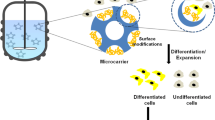Summary
The growth of Madin Darby canine kidney cells on microcarriers was studied at different cell seeding densities. Maximum growth was attained when a cell-to-bead ratio of 7∶1 was used. Under these conditions an initial concentration of above 3×105 cells/ml resulted in a yield of over 2×106 cells/ml in 2 d.
The amino acid utilization of cells from Dulbecco's modified Eagle medium was studied under the above conditions. Eight amino acids (arg, cys, gln, ile, leu, met, ser, and val) showed rapid and near complete depletion from the medium. Five amino acids (his, lys, phe, thr, and tyr) showed limited depletion. Two amino acids (ala and gly) were released into the medium by the cells.
Similar content being viewed by others
References
Van Wezel, A. L. Growth of cell strains and primary cells on microcarriers in homogeneous culture. Nature 216: 64–65; 1967.
Levine, D. W.; Wong, J. S.; Wang, D. I. C.; Thilly, W. G. Microcarrier cell culture: New methods of research-scale applications. Somatic Cell Genet. 3: 149–155; 1977.
Levine, D. W.; Wang, D. I. C.; Thilly, W. G. Optimization of growth surface parameters on microcarrier cell culture. Biotechnol. Bioneng. 21: 821–845; 1979.
Thilly, W. G.; Levine, D. W. Microcarrier culture: A homogeneous environment for studies of cellular biochemistry. Methods Enzymol. 58: 184–194; 1979.
Russell, W. C.; Newman, C.; Williamson, D. H. A simple cytochemical technique for demonstration of DNA in cells infected with mycoplasmas and viruses. Nature 253: 461–462; 1975.
Sanford, K. K.; Earle, W. R.; Evans, V. S.; Waltz, J. K.; Shannon, J. E. The measurement of proliferation in tissue cultures by enumeration of cell nuclei. J. Natl. Cancer Inst. 11: 773–795; 1951.
Davidsohn, I.; Henry, J. B. Todd-Sanford clinical diagnosis by laboratory methods. Philadelphia: W. B. Saunders Co.; 1969: 166.
Butler, M.; Darbre, A.; Arnstein, H. R. V. Amino acids attached to transfer ribonucleic acid in vivo. Biochem. J. 150: 419–432; 1975.
Roberts, R. S.; Hsu, H. W.; Lin, K. D.; Yang, T. J. Amino acid metabolism of myeloma cells in culture. J. Cell Sci. 21: 609–615; 1976.
Lambert, K.; Pirt, S. J. The quantitative requirements of human diploid cells (strain MRC-5) for amino acids, vitamins and serum. J. Cell Sci. 17: 397–411; 1975.
Stoner, G. D.; Merchant, D. J. Amino acid utilization by L-M strain mouse cells in a chemically defined medium. In Vitro 7: 330–343; 1972.
Crespi, C. L.; Thilly, W. G. Continuous cell proparation using low-charge microcarriers. Biotechnol. Bioeng. 23: 983–993; 1981.
Griffiths, J. B.; Pirt, S. J. The uptake of amino acids by mouse cells (strain LS) during growth in batch culture and chemostat culture: the influence of cell growth rate. Proc. R. Soc. Lond. (Biol.) 168: 421–438; 1967.
Tobey, R. A.; Ley, K. D. Regulation of initiation of DNA synthesis in Chinese hamster cells. J. Cell Biol. 46: 151–157; 1970.
Imamura, T.; Crespi, C. L.; Brunengraber, H. Utilization of carbohydrate by Madin-Darby canine kidney (MDCK) cells cultured in high density suspension of dextran microcarriers. Fed. Proc. 39: 2145; 1980.
Reitzer, L. J.; Will, B. M.; Kennel, D. Evidence that glutamine, not sugar, is the major energy source for cultured HeLa cells. J. Biol. Chem. 254: 2669–2676; 1979.
Tritsch, G. L.; Moore, G. E. Spontaneous decomposition of glutamine in cell culture media. Exp. Cell Res. 28: 360–364; 1962.
Author information
Authors and Affiliations
Rights and permissions
About this article
Cite this article
Butler, M., Thilly, W.G. MDCK microcarrier cultures: Seeding density effects and amino acid utilization. In Vitro 18, 213–219 (1982). https://doi.org/10.1007/BF02618573
Received:
Accepted:
Issue Date:
DOI: https://doi.org/10.1007/BF02618573




